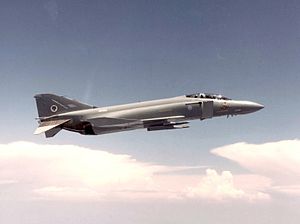McDonnell Douglas F-4 Phantom II in UK service
| F-4K Phantom FG.1 | |
|---|---|
 |
|
| A Royal Navy Phantom FG.1 of 892 NAS aboard HMS Ark Royal in 1972 | |
| Role | Fleet air defence fighter Air defence interceptor |
| National origin | United States |
| Manufacturer | McDonnell Douglas |
| First flight | 27 June 1966 |
| Introduction | 30 April 1968 (FAA) 1 September 1969 (RAF) |
| Retired | 27 November 1978 (FAA) 30 January 1990 (RAF) |
| Status | Withdrawn |
| Primary user |
Royal Air Force Fleet Air Arm |
| Produced | 1966–69 |
| Number built | 48 |
| Career | |
| Serial | XT595 – XT598 XT857 – XT876 XV565 – XV592 XV604 – XV610 (cancelled) |
| F-4M Phantom FGR.2 | |
|---|---|
 |
|
| A Royal Air Force Phantom FGR.2 of 23 Squadron at RAF Finningley in 1977 | |
| Role | Air defence interceptor Low level strike Close air support |
| National origin | United States |
| Manufacturer | McDonnell Douglas |
| First flight | 17 February 1967 |
| Introduction | 23 August 1968 |
| Retired | 1 November 1992 |
| Status | Withdrawn |
| Primary user | Royal Air Force |
| Produced | 1966–69 |
| Number built | 118 |
| Career | |
| Serial | XT852 – XT853 XT891 – XT914 XV393 – XV442 XV460 – XV501 XV520 – XV551 (cancelled) |
| F-4J(UK) Phantom F.3 | |
|---|---|
 |
|
| A Royal Air Force Phantom F.3 of 74 Squadron in 1984 | |
| Role | Air defence interceptor |
| National origin | United States |
| Manufacturer | McDonnell Douglas |
| First flight | 10 August 1984 |
| Introduction | 19 October 1984 |
| Retired | 31 January 1991 |
| Status | Withdrawn |
| Primary user | Royal Air Force |
| Produced | 1984 |
| Number built | 15 |
| Career | |
| Serial | ZE350 – ZE364 |
The United Kingdom operated the McDonnell Douglas F-4 Phantom II as one of its principal combat aircraft from the 1960s to the early 1990s. The UK was the first export customer for the Phantom, which was ordered in the context of political and economic difficulties around British designs for the roles that it eventually undertook. The Phantom was procured to serve in both the Fleet Air Arm and Royal Air Force in several roles including air defence, close air support, low-level strike and tactical reconnaissance.
Although assembled in the United States, the UK's Phantoms were a special batch built separately and containing a significant amount of British technology as a means of easing the pressure on the domestic aerospace industry in the wake of major project cancellations. Two variants were initially built for the UK: the F-4K variant was designed from the outset as an air defence interceptor to be operated by the Fleet Air Arm from the Royal Navy's aircraft carriers; the F-4M version was procured for the RAF to serve in the tactical strike and reconnaissance roles. In the mid-1980s, a third Phantom variant was obtained when a quantity of second-hand F-4J aircraft were purchased to augment the UK's air defences following the Falklands War.
The Phantom entered service with both the Fleet Air Arm and the RAF in 1969. In the Royal Navy it had a secondary strike role in addition to its primary use for fleet air defence, while in the RAF it was soon replaced in the strike role by other aircraft designed specifically for strike and close air support. By the mid-1970s it had become the UK's principal interceptor, a role in which it continued until the late 1980s.
In the late 1950s, the British Government began the process of replacing its early second-generation jet combat aircraft in service with the Royal Air Force (RAF) and Fleet Air Arm (FAA). At the time, the British aerospace industry was still a major source of equipment, and designs from several companies were in service. The 1957 Defence White Paper brought about a significant change in the working practices, the Government compelling major aerospace manufacturers to amalgamate into two large groups: British Aircraft Corporation (formed from the merger of English Electric, Vickers-Armstrongs, Bristol and Hunting) and Hawker Siddeley (formed from the merger of Hawker Siddeley Aviation, Folland, de Havilland and Blackburn).
...
Wikipedia
